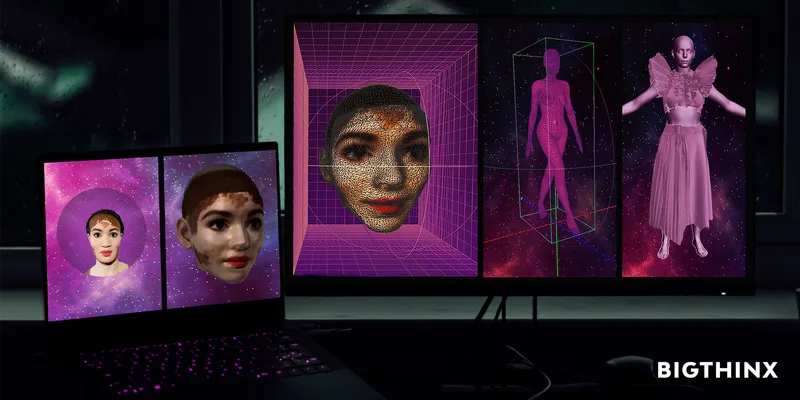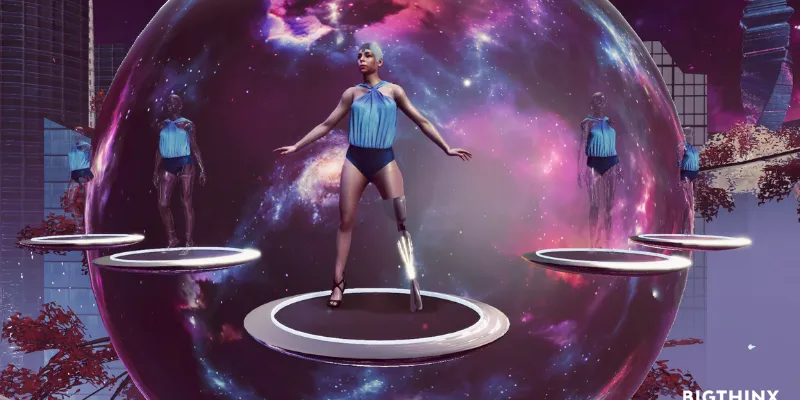Making Bigthinx possible with AI: This deep tech startup put virtual fashion on the ramp at New York Fashion Week
YSWeekender catches up with Shivang Desai and Chandralika Hazarika, the Founders of Bigthinx, which recently put on a virtual show that opened the New York Fashion Week. They speak on why virtual shows are at par with their on-ramp counterparts and the future in a post-COVID world
The pandemic turned the world upside down, and the fashion industry was no exception.
Fashion shows took a new turn amidst COVID-19 and virtual events became the new normal. Avatars replaced models on runways, but the catchy background score, the spectacular clothes, and the innovative designs remained a hit.
Since ‘virtual’ shows are not going away anytime soon, the need for technology in the industry is paramount.
Make way for Bigthinx, a fashion tech company that aims to disrupt the global fashion industry using artificial intelligence and computer vision for virtual people, digital clothing, and immersive fashion shows.

Bigthinx's AI generating the avatar of Vitiligo model Tiffany Taylor from USA
The startup’s neural networks create a personalised virtual avatar from photos and use AI to digitally recreate 3D clothing from any 2D image instantly to show how it would look, fit and drape.
Bigthinx, which is based in the Netherlands and has a tech team in Bengaluru, was founded by Shivang Desai and Chandralika Hazarika. It was formed in 2015 and pivoted to fashion retail in 2017.
Shivang is a serial entrepreneur and techie while Chandralika is a branding and marketing professional, who later turned her attention to digital entrepreneurship with a focus on building digitally empowered brands.
Amidst the pandemic, Bigthinx has ventured into digital models and virtual photoshoots, enabling brands to shoot catalogues and organise virtual runway shows completely digitally. As one of its solutions, it has done three virtual shows to date and recently created a completely virtual fashion show in collaboration with Fashinnovation at the New York Fashion Week.
In an interaction with YSWeekender, Shivang and Chandralika spoke about their new virtual show, how fashion events are evolving, how going digital benefits designers, and the future in a post-COVID world.

Shivang Desai and Chandralika Hazarika
Edited excerpts from the interview:
YSW: Can you tell us about your latest show?
Shivang Desai (SD): Our latest virtual fashion show at NYFW was inspired by pop culture, mythology, and the inadequacies of the fashion industry. We drew inspiration for the show from movies such as Blade Runner 2049 and video games like Cyberpunk 2077 to convey the emptiness of our pandemic-hit world.
The Winged Victory of Samothrace, an ancient Greek statue of the goddess of victory, Nike, formed the base for the show and is symbolic of a win for the world and for the fashion industry as it emerges from the ongoing health and economic crisis.
The centrepiece of the show was a gigantic sphere inspired by Michael Crichton’s novel, Sphere, and the subsequent movie of the same name wherein the object itself manifests the subconscious desires of anyone who looks into it. This is also metaphorical to show our subconscious desire as a species to transition to a world where inclusivity is normal and diversity is celebrated.

Rebecca Minkoff's look for the show
YSW: What was different this time around?
Chandralika Hazarika (CH): We went to the drawing board and re-envisioned everything, questioning every assumption about what fashion shows are supposed to be. As a result, models don’t walk a runway but move about on floating platforms.
Even the looks for models were re-envisioned - they all wore helmets and headdresses in different designs, doing away with hairstyles completely. The show takes place above a towering city skyline with a nebula as the backdrop, with definite science fiction tones to showcase a world of the future.
The core concept around this show was to highlight and make up for the lack of inclusivity in the fashion industry.
The idea of using a model in a wheelchair, and one who is an amputee, along with two models with the skin condition vitiligo, was to showcase that true beauty and grace are not restricted to perfectly shaped people but can be found in anyone, no matter their shape, size, colour, or condition. We used 10 models from countries like Uganda, Kenya, USA, Brazil, Holland, and India.
We also followed the show with a virtual showroom to illustrate that you can not only view a fashion show but can buy clothes.
YSW: Can you tell us about the amputee model from Brazil?

Amputee ballerina Mel modelling Satya Beachwear
CH: Mel Reis is an amputee model from Brazil. She is a ballerina who suffered a car accident in 2002 and went through 38 surgeries. In 2014, she finally decided to have her leg amputated and was fitted with a special prosthesis made especially for her to dance ballet. She performs at various shows as a ballerina now.
Our technology created her avatar automatically from her pictures and it was instantly ready to be part of the virtual fashion show.
YSW: How has the concept of avatars taken off?
SD: The pandemic has accelerated the fashion industry by at least five years. Avatars are the new us, and we have tremendous demand from fashion retailers around the world who are using or incorporating our avatar technology for virtual try-ons, fit models, fashion design, or to create their own brand-specific AI-generated brand ambassador.
It’s no longer limited to only the fashion domain.
YSW: How do you choose the designers for the show? Who were some of the top designers this year?
CH: The fashion designers were chosen in collaboration with Fashinnovation. The underlying theme was to showcase fashion designers with sustainability at the core of their businesses, and diversity of geographical location.
The show included designers from the US, India, Dubai, Japan, Brazil, and several other countries. Rebecca Minkoff participated as the showstopper.
YSW: Can you tell us about your collaboration with Rebecca Minkoff?
SD: Rebecca Minkoff was one of the speakers at the Fashinnovation Worldwide Talks and she agreed to be part of our virtual fashion show. Fashinnovation Founder Jordana Guimarães connected us to Minkoff, and we moved ahead with her and her team to create her look as the showstopper.
YSW: How do virtual fashion shows benefit designers and fashion enthusiasts across the globe?
SD: Virtual shows provide a platform for designers and enthusiasts to produce or experience a fashion show for themselves, from anywhere, at a fraction of the cost of real events. As a result, they are a much quicker and easier way of showcasing designs to a much wider audience globally.

Plus size model Jami from Holland in a look by sustainable designer Maria Maurio
YSW: In your opinion why are virtual shows better or at par with their real-world counterparts?
CH: While virtual shows cannot be called better because it is like comparing apples to oranges, they are certainly at par with real events as they allow an opportunity for far more creativity with clothing, set design, and production environments than traditional shows. They also cost only a tiny fraction of the cost of real events.
As a result, virtual mediums allow designers to express themselves, their concepts, and their vision much more fully than with traditional fashion shows because there is no limitation of physicality. In the virtual world, anything is possible.
Moreover, immersive virtual showrooms that can further add on to the shows enable brands and designers to sell their designs immediately after the show and go for production only when they get orders.
YSW: What were some of the international fashion trends that people seemed to love this year on watching your show?
CH: The biggest trend is the need for more inclusivity and diversity in fashion shows. The other huge trend is the attention to sustainability in the whole supply chain of fashion design. Designers that can prove that their products are more sustainable are clearly in greater demand.
YSW: What are some of the challenges of virtual shows?
SD: The primary challenge we faced was in educating designers and models on how and when to deliver pictures and designs. In normal fashion shows, designers are often working until the very last moment that the model walks on to the runway to make sure the look is exactly what they envision.
However, in order to produce a virtual show, pictures and details of the clothing need to be provided in advance to allow time to digitise them, which is something that designers are not used to. It also takes time and effort to get everything right, from set design and music to lighting and production.
YSW: Do you think virtual fashion shows will replace real ones in the future?
CH: We believe that even though digital fashion shows will not completely replace real ones, they will certainly become popular alternatives for brands that want to showcase numerous collections but don’t want to take on the burden and expense of real fashion shows.
They will also become a leveling channel for ecommerce brands and upcoming designers who cannot afford to put on traditional fashion shows and can benefit from a digital medium. This approach is far cheaper and much more sustainable than traditional methods, and we expect to see widespread adoption in the near future.
YSW: What are your plans for the future and the post-COVID world?
SD: We are an AI company focused on human body data and its applications across industries. Our long-term goals include expansion into various sectors such as gaming, fitness, healthcare, and other industries that can benefit from our research and technologies.
(Images credit: Bigthinx)
Edited by Teja Lele








![[App Fridays] TikTok lovers, are you ready for Firework, the new short video platform in town?](https://images.yourstory.com/cs/2/a182c7e0140711e987e2f7248b252f46/Firework1571401406063png?mode=crop&crop=faces&ar=1%3A1&format=auto&w=1920&q=75)